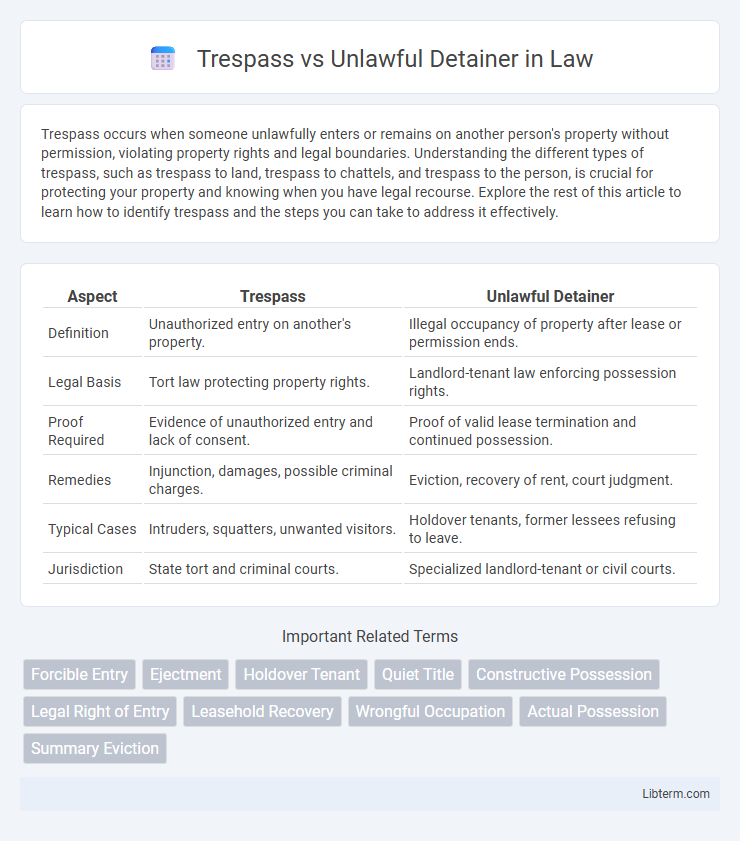Trespass occurs when someone unlawfully enters or remains on another person's property without permission, violating property rights and legal boundaries. Understanding the different types of trespass, such as trespass to land, trespass to chattels, and trespass to the person, is crucial for protecting your property and knowing when you have legal recourse. Explore the rest of this article to learn how to identify trespass and the steps you can take to address it effectively.
Table of Comparison
| Aspect | Trespass | Unlawful Detainer |
|---|---|---|
| Definition | Unauthorized entry on another's property. | Illegal occupancy of property after lease or permission ends. |
| Legal Basis | Tort law protecting property rights. | Landlord-tenant law enforcing possession rights. |
| Proof Required | Evidence of unauthorized entry and lack of consent. | Proof of valid lease termination and continued possession. |
| Remedies | Injunction, damages, possible criminal charges. | Eviction, recovery of rent, court judgment. |
| Typical Cases | Intruders, squatters, unwanted visitors. | Holdover tenants, former lessees refusing to leave. |
| Jurisdiction | State tort and criminal courts. | Specialized landlord-tenant or civil courts. |
Understanding Trespass: Definition and Key Elements
Trespass involves the intentional entry onto another person's property without permission, interfering with the owner's possession rights. Key elements include unauthorized presence, intent to enter, and physical entry onto land or property. Unlike unlawful detainer, trespass focuses on the initial unauthorized intrusion rather than possession disputes.
What Constitutes Unlawful Detainer?
Unlawful detainer occurs when a tenant remains in possession of a property without the landlord's consent after the lease or rental agreement has expired or been terminated. It constitutes an illegal occupation where the tenant refuses to vacate despite proper notice to quit or eviction orders. The key element is the tenant's failure to lawfully surrender the premises, often leading to a civil eviction process initiated by the property owner.
Legal Differences Between Trespass and Unlawful Detainer
Trespass involves unauthorized entry onto someone else's property, constituting a criminal offense or civil wrong, while unlawful detainer is a legal process used by landlords to evict tenants who remain after their lease expires or is terminated. Trespass cases typically address immediate removal and potential damages for intrusion, whereas unlawful detainer requires a formal court proceeding to regain possession of the property. The key legal difference lies in trespass focusing on illegal entry without consent, whereas unlawful detainer centers on the right to possess property despite prior lawful entry.
Typical Scenarios of Trespass
Typical scenarios of trespass include entering or remaining on private property without permission, such as walking into a fenced yard, breaking into a home, or refusing to leave after being asked by the property owner. Trespass often occurs in cases involving disputes over property boundaries, unauthorized access to commercial premises, or unauthorized camping on private land. Unlike unlawful detainer, which deals with wrongful possession after lawful entry, trespass emphasizes unauthorized presence or entry.
Common Cases of Unlawful Detainer
Common cases of unlawful detainer involve tenants who remain in a rental property after their lease has expired or after eviction notices have been served, often due to nonpayment of rent or lease violations. Landlords file unlawful detainer actions to regain possession of their property without addressing issues like property damage, which distinguishes it from trespass claims. These cases frequently arise in residential and commercial rentals where legal eviction procedures must be strictly followed to avoid wrongful eviction lawsuits.
Rights of Property Owners in Trespass Cases
Property owners possess the right to control entry and use of their land, enabling them to seek legal remedies against trespassers who enter without permission or lawful authority. Trespass laws emphasize protecting the property owner's exclusive possession, allowing them to demand removal and pursue damages for unauthorized intrusion. This contrasts with unlawful detainer cases that typically involve eviction processes against tenants violating lease terms.
Legal Remedies for Unlawful Detainer
Legal remedies for unlawful detainer primarily include the eviction process, where the landlord files a lawsuit to regain possession of the property. Courts may order the tenant to vacate the premises, and failure to comply can result in law enforcement removing the tenant. Monetary damages for unpaid rent or related costs can also be sought alongside possession orders.
Filing a Lawsuit: Trespass vs. Unlawful Detainer
Filing a lawsuit for trespass involves proving unauthorized entry onto private property without permission, often requiring evidence of intentional or negligent intrusion. In contrast, an unlawful detainer lawsuit focuses on evicting tenants who remain on the premises after their lease has expired or been terminated, necessitating documentation of proper notice and lease agreements. Understanding the distinct legal requirements and procedural steps for each case ensures the correct filing process and increases the likelihood of a favorable judgment.
Defenses Available to Accused Parties
Defenses available to accused parties in trespass cases often include proving permission to be on the property or lack of intent to enter unlawfully, emphasizing the absence of criminal intent. In unlawful detainer actions, defendants may argue improper service of notice, failure to comply with statutory eviction procedures, or that the landlord has breached the lease agreement, thus invalidating the eviction. Both legal defenses aim to challenge the plaintiff's claim by highlighting procedural errors or lawful justification for the defendant's presence.
Preventing Trespass and Unlawful Detainer: Tips for Property Owners
Property owners can prevent trespass and unlawful detainer by clearly posting no-trespassing signs and maintaining secure perimeter barriers such as fences and gates. Promptly addressing unauthorized occupancy through formal eviction processes and regular property inspections reduces the risk of prolonged unlawful detainer cases. Implementing thorough tenant screening and written agreements also minimizes potential legal issues related to unlawful occupancy.
Trespass Infographic

 libterm.com
libterm.com